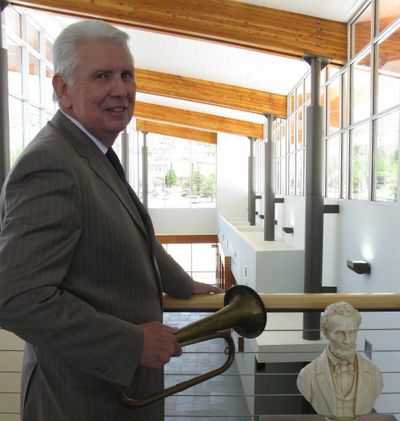Unique artifacts confirm indelible link between Idaho, Lincoln

BOISE – As a newly elected president, Abraham Lincoln sat for hours with plaster drying on his face to create a life mask that was used to fashion statues of the imposing man.
Five years later, in 1865, he sat for another life mask; the difference in his features is remarkable, showing him horribly aged by the Civil War.
Such an intimate look at the 16th president isn’t easy to come by, but thanks to a major donation to Idaho by former state Attorney General and Lt. Gov. David Leroy and his wife, Nancy, those artifacts and others will go on display next year in a specially designed gallery in Boise. The new gallery will open during the celebration of the sesquicentennial, or 150th anniversary, of the creation of Idaho Territory – another accomplishment of Lincoln’s presidency.
Leroy has spent years researching, writing and collecting the story of Idaho and Lincoln, who helped pick the new territory’s name and appointed all its initial territorial officers, including its first governor – his close friend William Wallace, whom Lincoln subsequently nicknamed “Old Idaho.”
Lincoln reported on the new territory in his 1863 and 1864 State of the Union messages, and even discussed Idaho territory business the day he died. During that meeting, he invited members of an Idaho delegation to join him that night at Ford’s Theatre to see a play, but they declined.
“Idaho, more than any other state, is related to Abraham Lincoln,” avers Leroy, who acknowledges that his claim arouses “considerable consternation” in Illinois, Kentucky and Indiana. “But I defend the claim, and am willing to contribute artifacts which support the claim in perpetuity.”
The unique collection documenting Lincoln and his ties to Idaho includes original signed documents, photos, portraits, busts, a 1,500-volume library of works related to Lincoln, and even a lock of Lincoln’s hair, taken at his autopsy by the surgeon general of the United States.
“Over the years, I have collected documents, tangible items, memorabilia that relates to that story of Lincoln and Idaho, Lincoln and the Rocky Mountain West,” Leroy said. “I’m interested in attempting to continue to tell that story to generations of Idahoans.”
Janet Gallimore, director of the Idaho State Historical Society, says she gets “goosebumps” thinking about what’s in store. “David’s collection is the finest collection of Lincoln material in the Intermountain West,” she said. “I’m just so excited that we will be acquiring this fabulous collection for the public. A great amount of Lincoln’s significance for Idaho is going to be presented to the public for the first time in an exhibition venue.”
The new Lincoln Legacy Collection and Exhibition will be installed at the Idaho State Archives, a light-filled structure that stands just down the road in Boise from the historic Old Idaho Penitentiary, which was in use in territorial times.
The archives now function mostly as a research facility; the new Lincoln gallery will be its first permanent exhibit open to the public, and is expected to draw busloads of schoolchildren and other visitors.
“(Leroy’s) vision was not just having it go to archives and no one gets to see it – his vision was to make it available to the public,” Gallimore said.
A glassed-in gallery, 60 feet long and 20 feet wide, will be constructed in an area that now contains study carrels, just off the archives building’s soaring lobby, with its glass walls facing the Old Penitentiary.
Visitors will enter a reproduction of Lincoln’s office as president, complete with fireplace, painting of Andrew Jackson on the wall, and a reproduction of the table at which his Cabinet met and Lincoln signed the Emancipation Proclamation.
“He penned the Pacific Railway Act, the Emancipation Proclamation and the Idaho Territory Act within nine months,” Gallimore said. “That sort of frames what was going on within our country.”
Then they’ll move through other small galleries documenting different phases of Lincoln’s life and ties to Idaho, ending in a reproduction of the Ford’s Theatre box where an assassin’s bullet took his life.
“We’ll frame the story of Lincoln and Idaho with Lincoln’s history as a lawyer, a legislator, the president, and then talk about what was going on in that era of U.S. history that really caused all of this to happen,” Gallimore said. “People get to have direct access to original materials that David has collected that really illuminate that story.”
The 1,500-volume scholarly collection will be housed in a special reading room at the other end of the archives building, adorned with Lincoln items, where scholars and others can access it for research.
State lawmakers this year approved $65,000 in infrastructure improvements to the archives building to allow for the new gallery; a $90,000 fund drive is raising private funds to complete it, and it’ll open in fall 2013.
Said Leroy, “The commitment is to attempt to make this a nationally unique, regionally significant collection of Lincoln materials that is a destination museum, exhibit and a substantial research facility for Lincoln scholars.”